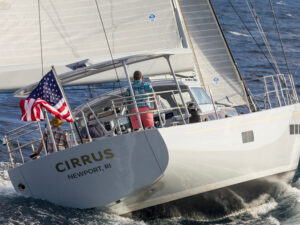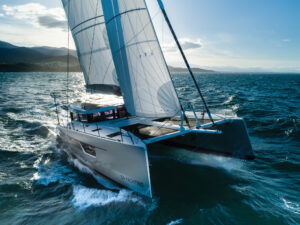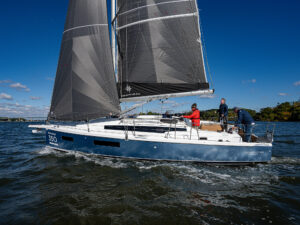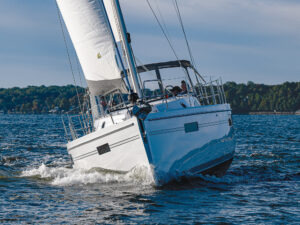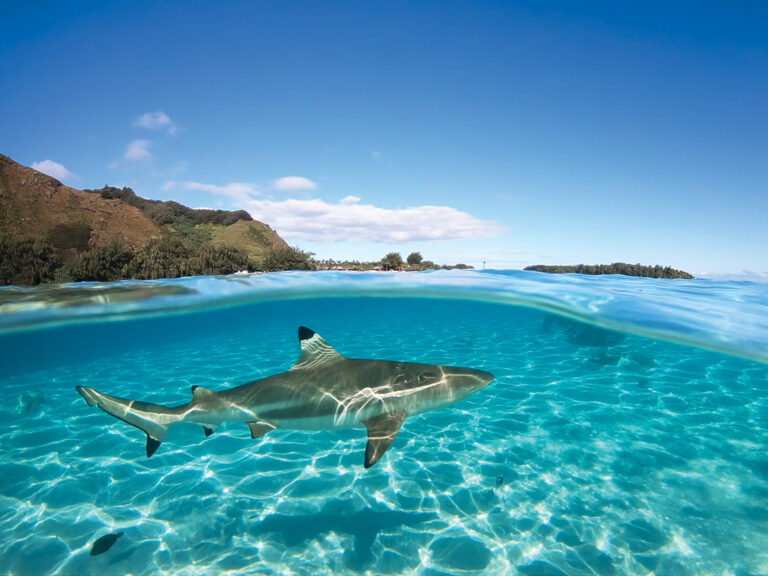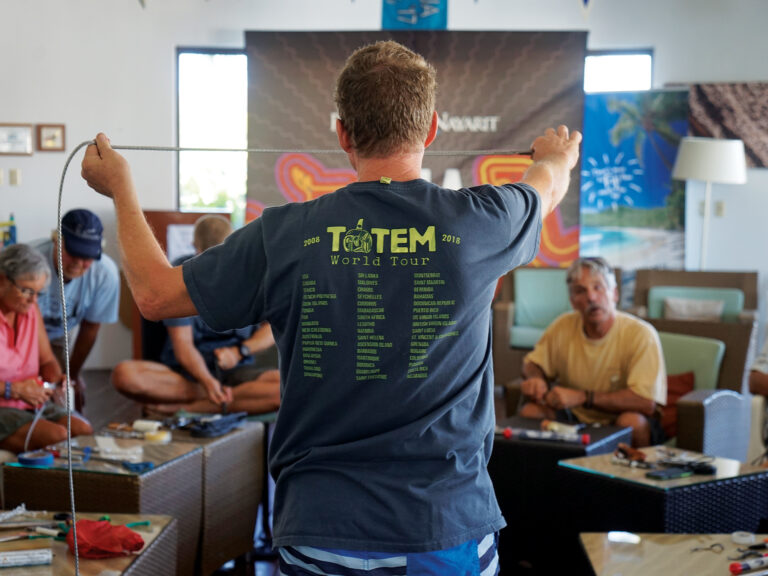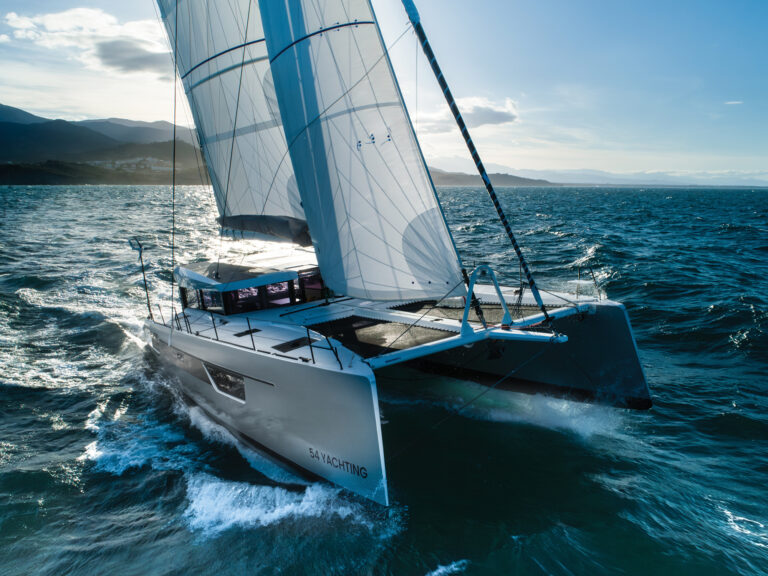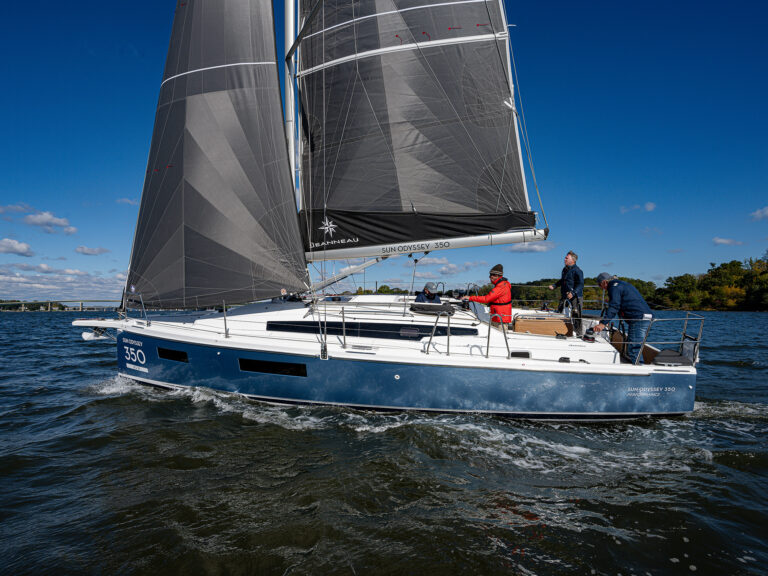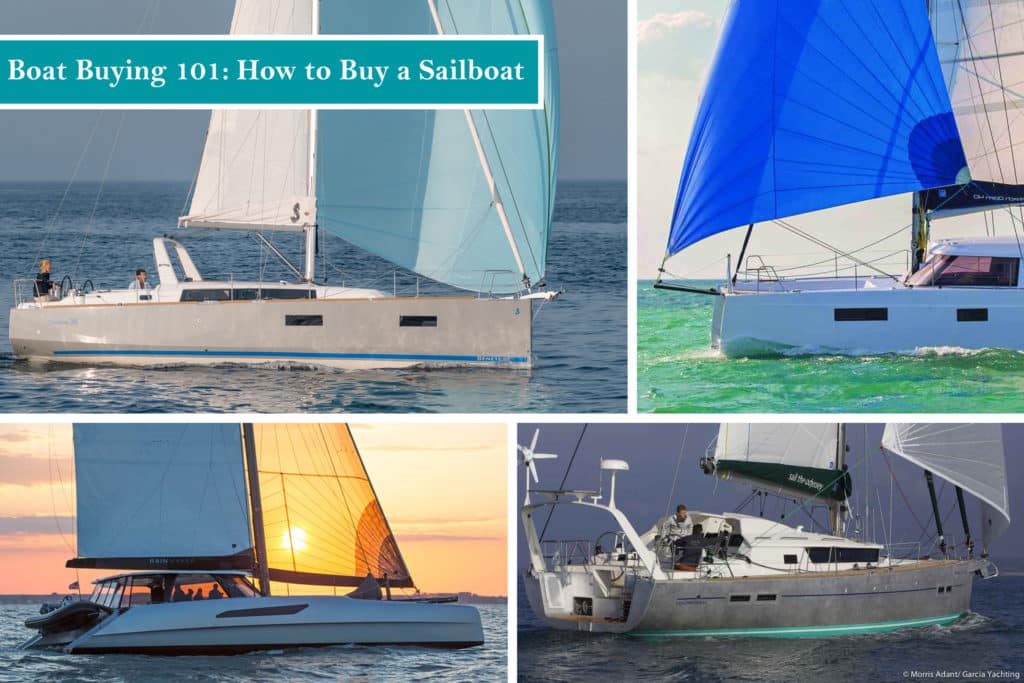
Boat Buying 101
Is spaciousness in a cruising boat a good thing? Stability? How about shoal draft? Affordability? Performance? Seakindliness? Maintainability?
As much as we’d love to say yes, yes, and yes, each of these traits compromises another. The more honest answer to all these questions is: It depends. Seasoned yacht designers wrestle with the first axiom of yacht design—every choice is a compromise—in every element of each new boat they create. You want a roomy stall shower in your 38-footer? Sure, that can be done, but you’ll have to trade away the spacious nav station to get it.
The key to shopping for your own cruising boat is to clearly understand the links between these choices, then use them to find the most elegant compromise for the sailing and living that you and your boat will actually do together.
Every year since 1994, Cruising World has empanelled a team of Boat of the Year judges to identify the best sailboats from builders all around the world. You don’t have to prod that word “best” very hard before the paradoxes poke out from under every side of it. To contain them, the BOTY judges closely question every boat’s creator to uncover the nuanced intent behind the design brief; only against that criterion, unique to every case, can the boat be judged. So now, let’s turn the tables. Instead of asking boatbuilders and designers what they intended when they created their Dreamboat 42, we’ll put that question to you: What are you really looking for in your next boat? Challenging your own assumptions just may surprise you and lead you to the best boat you never thought you’d own. We’ll pose half a dozen questions, then illustrate possible answers with boats built in the last decade, particularly those that stood out in our Boat of the Year contests.
The Middle or the Edges?
In the 1970s, that heyday of production-sailboat building, we saw the great flourishing of yacht-design compromise: boats that raced and cruised, slept six, crossed oceans, and fit into a 35-foot slip. CCA racing rules begat the long overhangs on legendary cruising boats from Pearson and Rhodes and Columbia. The exaggerated tumblehome on some “cruisers” from C&C and other builders doffed a cap to the IOR racing rules. And while the subsequent 30 years have brought plenty of refinements, still the legacy of that first generation of full-scale production sailboats poses a crucial question: Do you want a boat that lives near the middle of the design box; a cruiser with full living accommodations that’ll let you do some club racing; some lively daysailing; some overnighters; some ocean passages? Or do you want a boat that boldly lives near one of the edges of the design box, a boat that deliberately trades away one or several criteria for full-stop excellence in another? As you scan the field, keep this in mind. Particular boats at the middle or the edges will exemplify elegant compromises. The key is finding the ones that really fit you best.
A look at Beneteau’s range brings the point home. The world’s most prolific sailboat builder offers one line, now called Oceanis, that deftly exemplifies the middle of the box, addressing such elements as displacement, sail area, hull form, and layout with a moderation that appeals to many sailors by allowing the boats to be used in many different ways. Recent BOTY winners in this category include the Beneteau 34, 40, and 49.
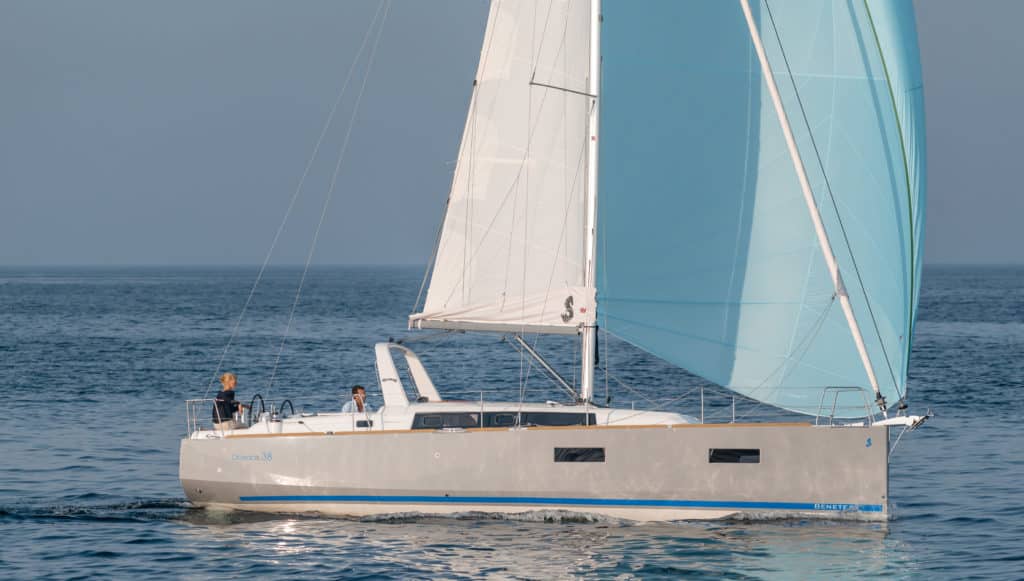
Meanwhile, the same builder offers two other lines that pointedly diverge from the centerline for more focused use. The Beneteau Sense 50 (2011’s Best Full-Size Cruiser), with it’s spacious, single-level layout on a wide hull form, invites a particularly social kind of cruising while turning away from straight sea berths, high bridgedecks, and small cockpit volumes—those design elements that traditionally telegraphed “offshore voyager.” And on the other side of the aisle, Beneteau’s First-series designs have traded away some of the cruising comforts of the Oceanis line for greater horsepower—and taken firsts in international regattas in the bargain.
We can see the same middle-vs.-edges difference in boats from other builders. Take the Catalina 309 and the J/95, two 31-footers that each won BOTY’s Domestic Boat of the Year award when they were introduced. The 309, like its award-winning bigger siblings, the Catalina 355, 375, and 445, exemplifies smart thinking from the middle of the box: full standing headroom, ample private sleeping cabins for two couples, complete working galley and head, plus tankage for a 200-mile motoring range.
The J/95, by contrast, trades that standing headroom for a low profile in a boat whose centerboard and twin rudders let you deftly sail into 3 feet of water. Designed by J/24 creator Rod Johnstone, the J/95 isn’t meant as a vacation home or a class racer like many of its siblings (including the J/133 that won Best Performance Cruiser in 2004) but rather as a fun, easy-to-sail weekender that does what it does emphatically well: take you daysailing, perhaps with a grandchild or two, right up to the shoreline.
Payload or Performance?
When we talk about the middle vs. the edges of the design box, those perimeters could represent any number of elements: luxury living spaces, all-oceans seaworthiness, straight-up speed. For now, let’s look at just one facet: the sliding scale that runs from payload to performance.
By payload, we mean the displacement required to make a boat a home. That means both interior space and the buoyancy in the hull form to carry the latest marine conveniences: genset, refrigeration, air-conditioning, entertainment suites, furniture-grade materials, and joinery. Hunter Marine exemplified the middle of this design box with boats like the Hunter 356, 38, 41 DS, and 49. Designed by Glenn Henderson, whose firsthand cruising experience included a year in the Caribbean aboard a 26-foot Pearson and whose deep performance-design credentials were honed in SORC boats, the Hunters of the last decade offered an exemplary blend of liveaboard comfort with boats you really want to take sailing, not just anchoring.
Now move farther toward the performance edge, and what do you get? Winners of the Best Performance Cruiser class—C&C 99 (2002), J/133 (2004), Sabre 386 (2005), X-46 (2006), X-34 (2009), as well as the Dufour 40 Performance Plus (Best Midsize Cruiser, 2009)—excelled at what they do precisely because they traded away some displacement for the light, stiff structure that invited their crews to pile on the sail area for a joyful ride.
Along another side of that edge are the so-called daysailers, a trend of lovely uncluttered machines whose performance is invested in the pure aesthetics of simple fluid dynamics. Optimized not for winning races nor for overnight or transoceanic passages but for simple shorthanded outings, highlights along this edge of the design box include the Morris M36, M42, and M52; the Sabre Spirit; the Friendship 40; the CW Hood 32; and the Hinckley DS42—all models from designers and builders who’ve also created standout craft from the middle of the design box.
Two (or Three) Hulls?
Multihulls are particularly defined by their place on this “payload or performance” continuum. The promise of displacement-busting speed depends on fine hull sections and minimum weight, while all that sprawling space between the hulls invites every comfort of a luxury condominium. One starting point for distinguishing multihulls on this sliding scale is to look at the displacement-to-length ratios of models built in the last decade. In the lightest third would be boats whose D/L falls between about 50 and 100: there you’ll find models from Gunboat, Outremer, Gold Coast, Soubise, Switch, Atlantic, Aeroyacht, Shuttlecat, and Fountaine Pajot.

In the middle group, with D/Ls ranging between 100 and 120, are boats from PDQ and Antares, Voyage, Dolphin, Maine Cat, Catana, Privilège, Lagoon, Fountaine Pajot, St. Francis, Nautitech, Discovery, and Seawind. In the final third, whose D/Ls range from about 120 to 200, are boats from Privilège, Leopard, Maxim, Dean, Seawind, Perry, Catana, Voyage, Lagoon, St. Francis, Voyage, Broadblue, and Admiral. Treat groupings like this with the caution that multihulls are particularly sensitive to the weight we put aboard them; the difference between light-ship and half-load displacement figures may be enough to bump a particular model into a different category, and you’ll see that some models appear in two categories. That said, you could make your own categories: sail area-to-displacement, tankage, displacement, or whatever detail is most important to you.
Also, keep in mind that lightness alone doesn’t equate with performance, and it certainly doesn’t confer seakindliness. To understand seagoing performance, try comparing real-world passage times. For the last 20 years, the Atlantic Rally for Cruisers has hosted transits of some 200 boats per year for the 2,700-mile Atlantic Ocean crossing from the Canary Islands to the Caribbean. For those of us who weren’t lucky enough to make those passages ourselves, the ARC results provide a gold mine of data. Look, for example, at the results from five years ago. Multihulls that posted between 180 and 200 miles per day in the 2007 ARC included a Fountaine Pajot 38, 44, and two 46s and a Lagoon 380 S2, 420, and 500. Multihulls that averaged between 200 and 230 miles per day included a Lagoon 410 S2, 440, 470, 500, and 55; a Catana 471; a Broadblue 385; and a Fountaine Pajot 43. Boats that averaged between 230 and 260 miles per day included a Fountaine Pajot 60, a Catana 471 and 582, and a Lagoon 570 and two 440s.
Note that one of the standout miles-per-day performers, the Lagoon 440, was also one of the most innovative boats on the payload side of the equation. As with the Lagoon 500, the flybridge-style helm station breaks through the typical space constraints of the boat’s size peers. In so doing, these models exhibit some of the most elegant compromises in the fleet.
Tested Tech or Innovation?
Of course, one of the ways to achieve cutting-edge performance is to employ cutting-edge innovations in materials or techniques. And that raises still another fundamental choice: Do you want a boat that lives in the comfort of settled technology? Or do you want to sail among the pioneers trying new things?
In half a century of composite boatbuilding, we’ve learned a lot. Solid structures of E-glass and polyester, sails of Dacron, rigs of aluminum and 7×19 stainless-steel wire, plus diesel engines and lead-acid batteries—all these technologies (among many others) are entirely predictable now. As a broad industry, we know their life spans, and we can identify the signs that indicate when it’s time to make replacements or repairs. But over the years, many innovations in boatbuilding design, materials, and techniques have come along to make sailing better. Cored hulls, better resins and reinforcing fibers, laminated sails, lighter and stiffer rigging, smarter propulsion and power distribution—all these innovations have been moving from the edges toward the middle for decades.
Among recent Boat of the Year contenders, we find fine examples from both sides of that question. The Leopard 38 and 44 (Best Multihull Cruiser and overall Best Import for 2010 and 2012, respectively) are Morelli & Melvin-designed cats built by Robertson and Caine in South Africa in close consultation with the folks who run The Moorings and Sunsail charter companies. What that means for these cats, in both the owner versions or the charter versions, is that these boats are built with a prime focus on the maintenance cycles—a vast database drawn from literally tens of thousands of charter days. Sailed from Cape Town on their own bottoms, these boats were honestly designed with the buoyancy necessary for all the conveniences and built with technology that’s been thoroughly tested over time.
For straight-up sailing, though, a different Morelli & Melvin-designed boat wins the plaudits of many a discerning sailor. Ask a roomful of pros what their dreamboat would be, and one name keeps coming up: the Gunboat. Beginning with the Gunboat 62 (Most Innovative, 2003) and followed by the 55, 60, 78, and 90, this line of luxury cats demonstrates what’s possible at the edges of boatbuilding design, materials, and technology. Epoxy resins, carbon-fiber spars, aramid rigging—these materials place the boat in a specialty zone when it comes to maintenance. But for those who are willing, there’s nothing so luxurious as the thrill of the power and speed that these boats deliver.
The innovations of a generation ago—asymmetric cruising spinnakers, cored hulls, deck-saloon layouts—have moved to the middle of the design box. Meanwhile, today’s builders keep trying things like hybrid propulsion (Lagoon), epoxy construction on a production scale (Tartan), and articulating transoms (Hunter) that could just break through the constraints of size and technology that others take as a given.
Eight Berths or Two?
A fundamental question we should all ask ourselves, given the limited volume of a sailboat’s hull, is how that volume should be divided. As noted earlier, the first wave of production sailboats turned every available surface into a berth to fit more folks in for the overnighters. The question for you is: How many people do you really want to shelter for the night?
Boatbuilders have offered refinements on both sides of that question. For more overnight guests, look to builders who regularly launch boats into the charter trade. They’ve worked wonders in providing virtually equal accommodations to two or three couples at once—often with a separate head for each cabin. The Jeanneau Sun Odyssey line (its 32 won Best Production Cruiser in 2003; the 40.3 won Best Value in 2005) offers variable layouts that let you install or remove bulkheads for two cabins or four.
On the other side of the equation are boats deliberately designed for a couple. Catalina has addressed this in several recent models. One of the most innovative interior layouts of the last decade is the Island Packet Estero (Best Midsize Cruiser Under 40 Feet, 2010), a 36-footer that altogether eliminates the ubiquitous V-berth, instead placing the dinette forward of the mast and ceding the aft sections to a luxurious couple’s cabin.
Cruising Far, or Wide?

Over the years, a host of builders have refined boats designed and built to address the traditional dream of many a cruiser: sell the house, leave the job, and head off over the horizon. Boat of the Year winners that were created to take you far in luxury include the Discovery 50 and 55; Hallberg-Rassy 37, 40, 43, and 62; Hylas 56; Kanter Bougainvillea 65; Malö 37 and 40; Morris 42; Najad 355; and the Passport Vista 545 CC.
But what happens when you separate the two parts of the phrase “far and wide?” I was on the 2011 Boat of the Year judging panel that gave the Cruising Spirit award to the Rodger Martin-designed Presto 30, a minimalist, wishbone-rigged ketch with camping accommodations and no standing headroom that nevertheless had our staff champing at the bit to take this boat—towed behind a full-size pickup, mind you—to explore Alaska’s Inside Passage, Mexico’s Baja peninsula, the Exumas chain in the Bahamas, and even high-latitude Hudson Bay. This would never be a sell up-and-set off kind of cruising boat but rather one that would let you keep your shoreside life fully intact yet interspersed with enough far-ranging sailing adventures in different places to build a whole life of memories on.
So, with that, we put the question to you: Would you like to go cruising far? Or would you like to go cruising wide?
Keeping Up With The Times
As we mentioned previously, modern innovations continue to redefine the sailing world, the sailboat market is constantly changing and new boats are being introduced. An important question to ask yourself is if you think these high performance boats are right for you, for example, Gunboat has released a new foiling catamaran – the G4 – as a performance cruiser. For some speed may be important, and for others it may be more about the trip than getting there quickly. While some modern cruisers are designed for ease, others are designed for a more advanced sailor and it is crucial to know the difference.
Some of the best cruising boats are tried and true classics from the last 30 years of boat building, and in fact, may people still prefer these iconic designs over the new sleek, high performance boats of today.

